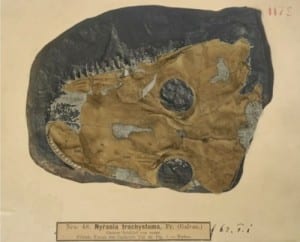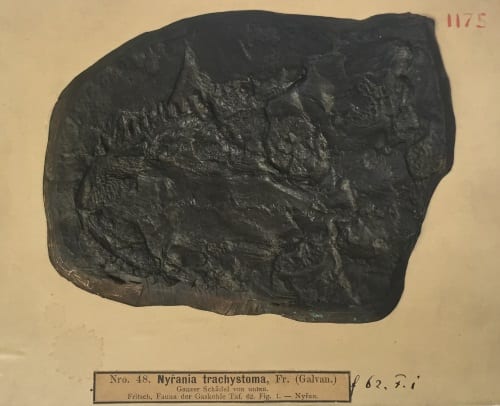Specimen of the Week 239: Bohemian fossil amphibian cast
By Tannis Davidson, on 13 May 2016

LDUCZ-W385 Cochleosaurus sp. with overlay of original illustration from Fauna der Gaskohle und der Kalksteine der Permformation Bohmens 1879-1901
Try to imagine life 310 million years ago. It is the Carboniferous period – a time when the Earth experienced its highest levels of atmospheric oxygen leading to the growth of vast forests which would eventually be laid down and become the coal beds characteristic of this period.
Primitive amphibians were the dominant terrestrial vertebrates including the Temnospondyls which were mostly semi-aquatic and typically larger than most modern amphibians. Superificially, most resembled crocodiles with broad, flat heads and had scales, claws and bony body plates.
This week’s Specimen of the Week celebrates these early amphibians with a lovely example cast from the famous fossil gas-coal of the Czech Republic…
**The Bohemian fossil amphibian cast**
Not just another pretty cast
As casts go, this one is rather special. Not plaster or resin, it is a copper electrotype (also known as a galvanotype). This process (invented in 1838 by Moritz von Jacobi) produces an exact facsimile of objects having irregular surfaces and was widely adopted for applications in printing, art and (more rarely) natural history. First, a mold is made from the fossil and then coated with fine graphite powder or paint to make it electrically conducting. A wire is attached to the conducting surface and the mold is placed in an electrolyte solution along with a copper anode wire (1). Introducing an electric current causes the copper atoms to dissolve and accrete on the mold. The result is a finely-detailed cast which replicates the most delicate features such as teeth, scales and tiny individual fossil bone AND robust enough to enable mass production of identical copies.
Bohemian gas-coal
What we are looking at here is an almost complete skull (seen from below) of a Cochleosaurus. This genus of extinct tetropods measured around 120-160 cm and is known from specimens found primarily in Nýřany in the Czech Republic. Found and named by the Czech palaeontologist Antonín Jan Frič (Anton Fritsch in German), the original fossil of this specimen was described in his four volume masterpiece on the gas-coal remains in Bohemia for which he became famous due to his contribution in the field of permo-carboniferous ecosystems (2). This celebrated work was filled with his meticulous illustrations of the fossils including the fossil from which LDUCZ-W385 was cast:
The brothers Frič
An interest in natural history was also shared by Antonín Frič’s brother Václav Frič (Wenzel Fritsch in German). Václav was naturalist and highly-respected, influential dealer in botanical, zoological and mineral specimens specialising in providing teaching aids in the field of comparative anatomy (3). His business offered for sale the electrotype casts based on the fossils featured in Antonín’s Fauna der Gaskohle und der Kalksteine der Permformation Böhmens (they were listed in the 1889 Paris World Fair catalogue) (4). The Grant Museum is fortunate to have both sets of the gas-coal electrotypes (one set of 18 casts, another set of 17 casts) which came to the Museum in 1984 from Imperial College following the closure of their zoology department. They are an exquisite record of the gas-coal fossils and testimony to the meticulous work of Antonín and Václav Frič.
Tannis Davidson is the Curatorial Assistant at the Grant Museum of Zoology
References
- Hatch, Harris B. and Alexander A. Stewart. 1918. “History of Electrotype Making”. Electrotyping and stereotyping. Chicago
- Frič, Antonín. 1879-1901. Fauna der Gaskohle und der Kalksteine der Permformation Böhmens
- Reiling, Henri and Tat’jána Spunarová. 2005. “Václav Fricˇ (1839–1916) and his influence on collecting natural history”. Journal of the History of Collections Vol. 17 no. 1 pg. 31.
- Ibid
One Response to “Specimen of the Week 239: Bohemian fossil amphibian cast”
- 1
 Close
Close




[…] about the fastidiousness of Václav Frič (and his palaeontologist brother Antonín Frič ) elsewhere on the Grant Museum’s blog but it must again be mentioned specifically in the context of the […]